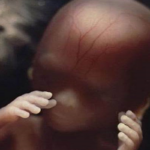Blog Post
“The quadruplets just started falling out of her”: The abortion horror story that made six clinic workers quit
By Jonathon Van Maren
On September 26, 2009, Abby Johnson was asked to assist with an ultrasound-guided abortion. Although she was the director of a Planned Parenthood clinic and had worked in the abortion industry for nearly a decade, she had never actually witnessed what takes place during an abortion procedure. She stared, transfixed with horror, at the tiny 13-week-old baby on the ultrasound screen as the baby fought for life against the suction aspirator that had invaded the womb. As the tiny child lost the fight and disintegrated into bloody slurry, that loss of life changed her life forever. She left the abortion industry, joined the pro-life movement, and now runs a ministry dedicated to helping clinic employees like her former self leave the abortion industry, too.
In 2011, following in the footsteps of former abortion workers such as Dr. Bernard Nathanson (The Hand of God) and Carol Everett (The Scarlet Lady), Abby Johnson published a memoir of her time in the abortion industry: Unplanned: The Dramatic True Story of a former Planned Parenthood Leader’s Eye-Opening Journey Across the Life Line. A film based on the memoir with the same title was released, with graphic depictions of abortion highlighting on the big screen the reality of what goes on in clinics across America every day. She joined me some time ago on my podcast to talk about her experiences in the abortion industry.
How did you end up working for a Planned Parenthood clinic in the first place?
I was a college student. I didn’t really know anything about Planned Parenthood, didn’t know anything about the organization, [and] I was approached by a woman who was trying to recruit students to come and work for the local clinic there. She started talking to me about Planned Parenthood [and] gave me all the standard talking points that we all hear all the time about how they’re there to help women and serve women and you know for me, I just thought well, this just sounds like a good organization.
She did ask me what I thought about abortion. I told her that I was I was raised pro-life, and she told me that she thought that was great. And you know: Pro-lifers just didn’t understand about back alley abortions. I was really naive and very ignorant to either side of this issue and I was very easily convinced by her. I mean, this was her job–to go out and sell their talking points, that they were on the right side of this debate. And [I didn’t] really know that there was this heated debate about abortion. And so I was just really naive and got involved that way. And once I was in, I started meeting these women, and I really did think that I was I was doing the best thing for them, that I was doing the right thing at that time.
I’ve read your book and a lot of the columns you’ve written are specifically about the sorts of things you saw and the things that you witnessed and experienced inside the Planned Parenthood clinic. What were some of the things that you experienced inside the Planned Parenthood clinic that in retrospect made you look back and say, wow, I can’t believe I didn’t see that at the time?
I think 2009 was really a that was a pivotal year for me. That was the year that I left the clinic, but I was really getting into high branches of management within Planned Parenthood. I was sitting in really confidential meetings with National Abortion Federation and Planned Parenthood. I remember my boss telling me so clearly, I remember we were talking about these patients and [I said that if they] didn’t have money, can we just see them anyway. And this wasn’t even for abortion. And I remember my boss telling me non-profit is a tax status, not a business model. And it was in those meetings that I learned that we were expanding abortion to or through the six months of pregnancy at our affiliate. That was very troublesome to me I had always said that I would never support abortion past the point of viability…most people who are pro-choice do have a line in the sand. And for most people who support abortion, that line is viability. That that’s where it is, and that that’s where mine was, too.
And then being instructed to double our abortion quota, a certain number of abortions that we had to sell to women. All of that just really flew in the face of what I thought we were about for so long. I mean gosh, President Clinton, Obama, even the president of Planned Parenthood [are] still going on TV and saying you know, our goal at Planned Parenthood is to keep abortion safe legal and rare. If that’s true, then why are we doubling our abortion quota? Why do we have an abortion quota to begin with? All of those different realities that I was confronted with really caused me to look back over my eight years with the organization and say wait a minute, is it that the organization is changing or is it just that now I’m finally seeing what we’ve been about all along?
And all those little things sort of added up to, I think, a softening of my heart, and really allowing me to see with clear eyes what I saw on that ultra-sound guided abortion. Seeing this child fighting and struggling for his life and knowing that here I have been for eight years. Telling people, telling myself, that a woman’s right always superseded the right of her child. Yet I was confronted with this reality that our humanity was equal, that our dignity was equal, and because of that I knew that that I was on the wrong side of this debate.
It’s actually the things that you heard the abortion activists and the Planned Parenthood staff members and those business leaders? It was the things you heard from them behind closed doors that started moving you away from them as opposed to anything you heard from pro-lifers?
I think that there were there were definitely seeds of truth that I heard. You know, I used to go as a spy. Pro-life events and like that. And I think there were seeds of truth there. I grew up in a pro-life home. I recall I would go to these events and say, oh yes, I know, I remember hearing my parents say that. It wasn’t really what they said but it was how they treated me, how the people on the sidewalk treated me. It wasn’t yelling in my face or calling me a killer or a murderer. It was simply reaching out. They did confront me with hard truth sometimes. Sometimes they did. I mean for eight years, telling me that we’re here, we’ll help you get another job, we’ll help you get on your feet. You don’t have to do it alone.
It was an important combination, because I saw the truth of what was happening in the clinic, but then I also knew that I had a really strong support system to go to. And so when I left, it would have been very easy for me to say I’m leaving my job, I’m just going to go slink away get another job and never talk about it again. But I knew that I have the support of the people on the block who had always been respectful and kind to me, and so that was where I felt drawn to go. I am incredibly thankful for the support that that they showed and that they offered.
When you see that in these upper level meetings you guys were asked to sell more abortions essentially to contribute income to the business model, how exactly did they say you should sell abortions? I understand you’ve written about this at length, how abortion is just presented as part of healthcare. How is that accomplished?
Our directive was to turn every encounter, whether on the phone or whether in the clinic, every patient encounter into a revenue-generating visit. So if a woman comes to us and she says, I’m pregnant, there’s really only there is only one way that we can turn that into a revenue-generating visit, and that is to sell her an abortion. Planned Parenthood is not in the business of providing prenatal care. It’s not like they have some sort of adoption referral resource, so the only way that we could make money off of a pregnant woman was to sell her an abortion, and so we were trained how to do that. We were trained how to overcome various objections that she may have to abortion, particularly religious arguments, because we knew that the majority of women walking into abortion clinics to have abortions identify as Christian.
So it was important to us that we had some arguments to go against questions like: Do you believe God will ever forgive me? Do you believe abortion is a sin? Things like that. And so you’re trained how to sell a product. We would say, well we can do an ultrasound today find out how far along you are. They would say OK, they give us one hundred dollars. Then we would take them back into the room and say well, if you go ahead and schedule an abortion today, I’m authorized to credit a hundred dollars to your abortion procedure. Otherwise if you don’t schedule, then you’re going to be out with hundred dollars and after paying again. So there’s different techniques that we used to really sell this product to the women who were walking in.
You have discussed at length in several other interview what it was like to actually see the parts of the babies after the abortion was completed. How did the clinic workers react to seeing that?
You know, for me it didn’t really bother me when I saw it for the first time. For some clinic workers, you know, they didn’t want to see it. They just thought it was gross. They’d want to see all the blood, you know but for the group of us who worked back in the [POC] lab, the products of conception lab, it’s hard to really know why [it didn’t bother me.] I really don’t have an explanation. But doing that work piecing the body parts of baby together was not something that [bothered me.]
When the baby body parts scandal broke you came out and you actually said Planned Parenthood is lying. This is actually taking place. And to this day, Planned Parenthood is still denying that any of that happened, and they’re trying desperately to make sure that none of the remaining footage that’s possessed by the Center for Medical Progress ever comes out. What is Planned Parenthood actually doing, speaking as somebody who actually worked behind the scenes for almost 10 years?
It’s interesting to me that they even try [to deny it.] Well, I guess what they’re denying is that they make income off of it. So they’re not denying that, but this research on aborted tissue, this fetal research actually takes place. You know, when I worked at Planned Parenthood, I was involved in a clinic, an affiliate that did participate in that program…we sent the entire baby to the lab tech company [doing studies], and we got about two hundred dollars per baby that we sent over there. As long as they line item that correctly, then technically, as long as it’s not a government-funded research program, then it was legal in Texas. Now it’s not anymore. We passed laws to ban monetary transactions for aborted body parts, but at the time it was legal.
Let’s go for a moment to the really key event of both your book as well as of the upcoming film based on your book, which is the moment you had to assist in an ultrasound-guided abortion, and you saw, in your words, a baby fighting for his or her life on the screen. Can you describe that moment?
I was very nervous because I had never participated like this before and or in an ultrasound-guided abortion, which is typically not the standard protocol used inside of abortion facilities. But when I when I saw it take place, I was just really disgusted, really shocked, and just honestly felt really stupid for believing, so eagerly believing, the lie that the abortion industry had fed me for so many years. Like I worked there for eight years. I really bought into it, for whatever reason–because I liked my salary, because I liked the prestige, I liked the award, I liked famous people I got to meet, whatever it was. You know, I had done all of this, and I had essentially coerced women into making a decision for abortion that was sacrificing their children, and I knew that that was incredibly unjust. And I thought here I am working this organization that says we’re here to fight for justice for women. But at what cost. I mean, there’s no justice. And we’re having to sacrifice the rights of someone else.
What was it that you saw in the ultrasound that was so different from all the previous experiences that you’d had? You know, helping with the products of conception like a lab and all these things. What was it that you saw in the ultrasound that that made that experience more jarring? What made that experience change your mind where previous experiences hadn’t?
It wasn’t seeing the death of her child that caused me to change my mind, which is why I think I wasn’t really disturbed by what I saw in the POC lab, or what I saw in graphic images. I knew what was happening. Seeing the death of the child didn’t really affect me, but it was seeing the life of this child. Recognizing that this child had the same reaction to danger that any of us would have. That there was this fight or flight response that was inside of this child, even at 13 weeks, and just seeing that we were the same. We were different sizes, we were in different locations, but that our humanity and our dignity was the same, and to see that dignity stripped away from someone–it’s almost unbearable to watch something like that. So wasn’t the gore of abortion that changed my mind, it was really the humanity of this innocent child. That’s what caused me to rethink all this.
What did you do right after you saw that? You’d worked there for almost a decade. You’d been a model employee at Planned Parenthood. You’d climbed the corporate ladder. So after seeing this, what did you do next?
Well I went home that day and I was trying to wrap my head around what I seen and just trying to gain some perspective. I remember talking to trying to talk my husband about it. My husband was pro-life and has always been pro-life, and [was saying], Abby, I just don’t want to hear that. [and I said], Well you gotta, because I don’t know [anymore.] And so I was sharing that with him and he looked at me and he said, Well now that you’ve seen the truth what are you going to do?
And I said, Well, I don’t want to be involved in abortion anymore. You know, I didn’t have this this like immediate I’m 100 percent pro-life now. That wasn’t what it was. It was just like: I don’t want to have my hands involved in it anymore. So I think I have to leave. I didn’t think that I was going to be able to leave my job at Planned Parenthood until I had another one lined up. But when I went back to work, [we were] doing surgical abortions that day. But we were giving the medication abortion pill and I was looking at these women. They were coming into the clinic with these little brown paper bags. I knew that they were coming into our clinic, taking a pill that was killing their baby and going home to flush their baby down the toilet.
And I just thought, I’m still here. I’m still doing it. I’m still profiting off of the killing of these children. So that was that was the day that I decided that I couldn’t do it anymore and that I needed to leave. And so that was when I went to go meet with the Coalition for Life pro-life groups in my town and decided to go ahead and put in my resignation. And I was lucky because I was very blessed that I grew up in church. I grew up with a strong faith foundation. I had a good support system. I had faith that God was not going to leave me, that He was going to be there as long as I followed in his will and so I felt comfortable to leave it and knowing that my parents were there to help as well.
How did Planned Parenthood react to you leaving?
Well you know in the beginning excuse me took me to court to try to get a gag order against me. That failed. I’ve come out with things talking about abortion quotas or something, and they have to make a statement saying, you know, we don’t have abortion quotas, and then I’ll come out with proof that they do from a from a budget from a clinic worker. And then they have to retract it. Well, you know, yes, we do. So now when I make a statement about them, I think they’ve learned that’s happened about three times. So I think they were just stay quiet because I think they don’t know what evidence that I might have up my sleeve that they could show that they really are doing this.
So your organization now according to your website has helped 430 people leave the abortion industry in total. If you had to take just one story from all those stories to share with our listeners which story would you pick?
I need to update that. We’re now at 487. I think one of the most impactful story that we’ve come across is a gal that works at Planned Parenthood in Maryland. There was a woman who came in and she was naturally pregnant with quadruplets. Her boyfriend had taken her to another clinic to have forced abortions, and the woman had become very ill. She came into the Planned Parenthood, and of course there’s no doctor there unless they’re performing abortions. There’s no doctor on site, so here all these women who are probably medical assistants, and they’re trying to help this woman and the quadruplets just start falling out of her. It was heartbreaking for them to witness that experience. That, and so one of one of the women who was in the room during that time–she ended up leaving. All six of them that were involved ended up leaving the clinic, and they all came through our ministry, and subsequently that facility had to put a halt to performing abortions for quite some time until they could find new employees. So who knows how many lives were saved during that time because there was no abortion access in that community.








